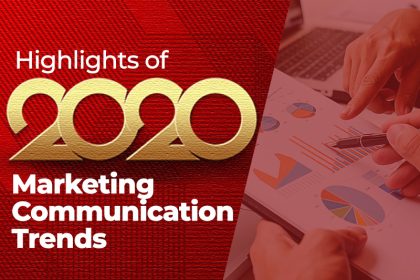Highlights of 2020 Marketing Communication Trends

Technology has greatly disrupted marketing communications practices as brands continue to seek better, yet, cost-effective ways to connect and engage with audiences across board. While it is imperative to know that Artificial Intelligence (AI) and data-driven marketing strategy will certainly be a big trend in 2020, focus will be more on people than technology.
There’s a pushback against the increased digitization and automation of interactions between brands and consumers, thus the desire to make marketing more human again. Marketers should look out for these trends to guide their marketing communications for 2020.
An Interactive Content Bang
According to PR Daily, more than 90% are hungry and begging for more interactive content. As such, content marketing will shift focus to give people what they want. To keep customers constantly engaged, marketers should look out for interactive content, using augmented and virtual reality, gamified quizzes and polls, online events and “shoppable” content.
To build more meaningful and authentic engagements with customers, businesses will begin to use chatbots. Inspiration and innovation for developing products and services will spring forth from savvy marketers using chatbots. Digital teams in companies need to do more research about the likes and dislikes of their customers, and gather real quotes from customers.
Social Media Influencer Shakeup
What does 2020 hold for social media influencers? Well, 2020 is looking like the game changer for social influencers especially for those who buy likes and make up phony engagements. Brand managers have now become nifty to verify influencers, tracking ROI and adjusting their media mix accordingly. Also, consumers are no longer buying into influencers who rep brands consumers consider authentic to them. Expect to see more micro-influencers being favored over macro-influencers.
Improved Personalized Brand Experiences
According to a survey by Epsilon, 80% of consumers say that they would be more likely to do business with brands that provide personalized experience. With the dynamic nature of the artificial intelligence, putting curated, highly targeted ads directly before individuals who are most likely to buy may be complicated. However, new technologies will produce highly accurate customized recommendations. Savvy marketers can better understand customers and motivations for buying at each point of sales.
Enunciated Voice Marketing
A research by PricewaterhouseCoopers (PWC) states that 61% of those ready to use voice device intend to increase usage in the future, especially within the ages of 25-64 years. According to Google, 20% of searches done on Google are currently voice driven. Looking at the PWC report, the percentage of voice search will most likely increase in the future. Google Home, Amazon Echo and other forms of smart speaker are fast becoming household items.
It is also expected that the base of installed smart speakers will reach 225 million units by 2020 and 30% of all web searches will be done without a screen. Marketers need to outline how voice marketing should be integrated into their overall marketing strategy. Even if brands are not prepared for smart speaking advertising, it is paramount that their content is well optimized for voice search.
SERP Zero Position
There has been a major shift in the SEO industry in the last decade. Being number one in the search engine result pages (SERPs) is no longer the primary goal for marketers due to changes in browsing behavior. Over 60% of search results returned by Google are now categorized as position zero search results. Marketing communications pros are still trying to figure out how to attain position zero as it requires different SEO techniques than those employed for normal listing in SERPs.
Transformed Strategic Marketing
Strategic thinking will be a key role in 2020. Marketers need to think beyond the usual and begin to provide answers to the “why” questions. For businesses to achieve a transformational marketing strategy, there has to a synergy between data collection, technology and customer engagement. Strategic marketing plan defines goals and determines which marketing tactics will be employed to reach customers at all touch points.
From Omnichannel to Optmichannel
Marketers in 2020 will have to adopt a more holistic approach to channel engagements. To realistically achieve this, marketing communications pros will have make more strategic decisions based on the brand promise, customer expectations, personal preferences and anticipated return on investment.
The Pop-Up Comeback
Brands such as Toy ‘R’ Us and Barneys are making a return via pop-ups. Retailers are beginning to host pop-up events aimed at creating unique and memorable experiences. The goal of pop-up store is to build brand interactions that make a lasting impression with the customers. Brands or marketers should be conscious of this as the new form of brand promotion and engage consumers through mammoth activation.
More Use of Live Videos
The live video industry is projected to worth over $70 billion by 2021; and consumers are getting big on the live videos. Live video element on social media pages such as Facebook and Instagram creates a more engaging experience for consumers, giving them a feeling of being part of the engagement.
The new decade sure seems like an interesting year for technology, businesses, marketers and most importantly the consumers since there a lot of innovative trends going on. For marketers who do not have a solid plan yet, it is not too late to go ahead, using all information at their disposal to dominate the digital marketing landscape in 2020.
References
https://www.prdaily.com/2020-vision-the-top-5-emerging-trends-in-marketing-and-pr/
https://marketinginsidergroup.com/marketing-strategy/2020-marketing-trends-you-need-to-know/






